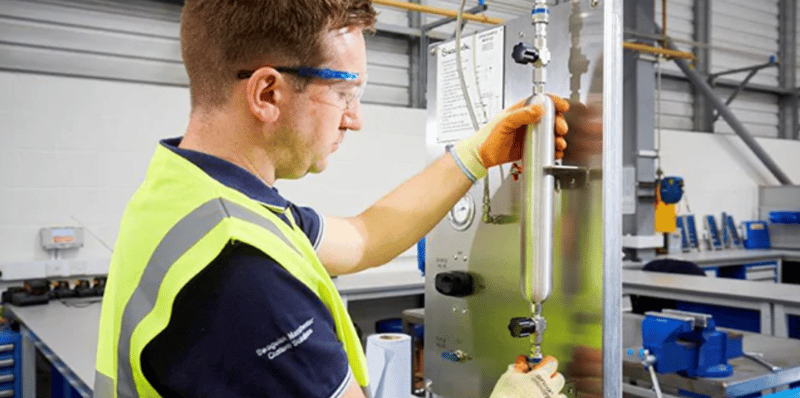Share this
Choosing Among Gas Sampling Methods for Northern California Refining Processes
by Morgan Zealear on 6/24/21 9:00 AM

Gas sampling is a critical function in Northern California refineries and can be used to inform a wide range of processes as well as means to meet strict requirements from the Bay Area Air Quality Management District (BAAQMD). There are three standard methods for gas sampling: spot sampling, continuous composite sampling, and continuous online sampling. Understanding the basics of each sampling method can help determine which method should be employed for refinery applications.
Gas Sampling Methods
Let’s take a look into what each gas sampling method entails and how these methods are typically used throughout a Northern California refinery.
Spot Sampling
Spot sampling is by nature different from composite and continuous sampling. Continuous composite sampling occurs when the sample is being taken either for a specified amount of time or a specified quantity of flow. Continuous sampling speaks for itself.
Spot sampling is performed to provide insight into a sample taken at a given point in time and is performed through the use of a grab sampling panel. Spot samples are typically taken on-site then transported to a laboratory for analysis. Because of this, they should not be used for time-sensitive sample analyses. Spot sampling is a simple and easy way to sample and analyze gases throughout refineries, but it has the potential to provide a misrepresentative sample, as it is a single sample taken at a single point in time. However, obtaining representative samples with spot sampling techniques can be done through proper placement of the sampling system and well-defined procedures.
Spot sampling procedures include:
- Evacuated Container Method
- Reduced Pressure Method
- Helium Pop Method
- Floating Piston Cylinder Method
- Water Displacement Method
- Glycol Displacement Method
- Fill and Empty Purging Method
- Controlled Rate Purging Method
Note that procedures 1-3 require evacuating the sample cylinder to a pressure of 1 mm Hg and procedures 4-6 are constant pressure methods that may be used when the cylinder and sample line pressure must remain equal.
Applications in Northern California refineries may include the analysis of:
- Hydrogen content, sulfur content, or full gas composition of recycled hydrogen in hydrotreating units
- Gas composition in fuel gas system may occur at the fuel gas header or at various units dispersing gas into the fuel gas header
- Gas composition at vapor recovery systems
- Fuel gas byproduct produced by hydrocracking units
- Flare gas composition
Continuous Composite Sampling
As previously mentioned, continuous composite sampling can be characterized as either flow-based or time-based. Continuous composite sampling acts as the middle ground between spot sampling and continuous online sampling. This method is essentially a series of small spot samples taken over a given amount of time or given quantity of flow. This allows the ability to take a number of samples and average various values to better understand the gas composition.
A composite gas sampling system typically consists of a sample collection pump, a probe, an instrumentation supply system, a timing system, and a sample cylinder. Representative samples can be obtained through proper probe placement (ideally in the center third of the flow stream) in the correct location which avoids the presence of stagnant gas and turbulent flow due to piping elbows and/or orifice fittings. In Northern California refineries, continuous composite sampling is less commonly used for gases, but may be used for applications such as flare header gas composition analysis.
Continuous Online Sampling
Continuous online sampling is a gas sampling method used for time-sensitive gas analyses or for gases that must always be monitored, whether to inform critical refinery processes, maintain safety requirements, or comply with environmental requirements pertaining to BAAQMD. Continuous online sampling provides a steady stream of real-time process conditions or gas compositions. This method allows for operators to be proactive and can reduce sampling errors that can occur with the previous two methods.
Although continuous online sampling systems require a more complex installation compared to the previous methods, they also boast many benefits. Samples do not require operators to be present due to the automatic nature of the method. Additionally, a wealth of data is gathered and automatically recorded in a distributed control system (DCS). The DCS system can be programmed to send out alerts or alarms when measured values approach or exceed a given value or range, allowing for operators to act quickly.
Applications in Northern California refineries may include the analysis of:
- BTU content in the natural gas system
- BTU content in the fuel gas system
- Hydrogen content in various hydrotreating units
Determining the Correct Gas Sampling Method
I hope this brief overview of gas sampling methods provided insight into the basics of each method as well as an understanding of where each method might be appropriate in Northern California refinery applications. However, the ability to obtain representative and informative gas samples depends on many other factors, including sample location, material selection, hydrocarbon dew point, pressure and temperature parameters, and proper component and instrumentation selection.
If you are still unsure of which sampling method is appropriate for your use case, our Swagelok Northern California Field Engineers can perform an onsite evaluation of your process to help you determine which gas sampling method is best suited for your process and your needs. Swagelok Northern California has been working with Bay Area refineries to design and fabricate sampling systems for a wide range of applications. We are well-versed in refinery sampling applications and can help provide reliable and efficient sampling solutions to Bay Area refineries.
To find out more about how Swagelok Northern California can help you determine the correct gas sampling method for your refinery processes, contact our team today by calling 510-933-6200.
 Morgan Zealear | Product Engineer – Assembly Services
Morgan Zealear | Product Engineer – Assembly Services
Morgan holds a B.S. in Mechanical Engineering from the University of California at Santa Barbara. He is certified in Section IX, Grab Sample Panel Configuration, and Mechanical Efficiency Program Specification (API 682). He is also well-versed in B31.3 Process Piping Code. Before joining Swagelok Northern California, he was a Manufacturing Engineer at Sierra Instruments, primarily focused on capillary thermal meters for the semiconductor industry (ASML).
Share this
- Archive (465)
- Assembly Services (207)
- About (100)
- Seal Support Systems (96)
- Best Practices (88)
- Training Services (74)
- Fittings (51)
- Semiconductor Applications (49)
- Hoses and Flexible Tubing (47)
- Regulators (44)
- Tubing (42)
- Grab Sampling Systems (32)
- Sampling Systems (32)
- Gas Systems (30)
- Services (30)
- Downloads (29)
- Valves (24)
- Application Support (18)
- Orbital Welding (17)
- Case Studies (13)
- Steam Systems (13)
- Frequently Asked Questions (12)
- Tools (12)
- Measurement Devices (7)
- Subsystems (6)
- Thermal Management (6)
- September 2023 (1)
- August 2023 (2)
- June 2023 (1)
- March 2023 (3)
- February 2023 (3)
- January 2023 (4)
- December 2022 (4)
- November 2022 (4)
- October 2022 (4)
- September 2022 (1)
- August 2022 (3)
- July 2022 (2)
- June 2022 (4)
- May 2022 (1)
- April 2022 (2)
- March 2022 (1)
- February 2022 (2)
- January 2022 (3)
- December 2021 (1)
- November 2021 (6)
- October 2021 (6)
- September 2021 (8)
- August 2021 (4)
- July 2021 (3)
- June 2021 (6)
- May 2021 (6)
- April 2021 (7)
- March 2021 (5)
- February 2021 (4)
- January 2021 (6)
- December 2020 (5)
- November 2020 (6)
- October 2020 (6)
- September 2020 (8)
- August 2020 (7)
- July 2020 (8)
- June 2020 (8)
- May 2020 (6)
- April 2020 (9)
- March 2020 (7)
- February 2020 (10)
- January 2020 (21)
- December 2019 (23)
- November 2019 (21)
- October 2019 (22)
- September 2019 (21)
- August 2019 (22)
- July 2019 (23)
- June 2019 (20)
- May 2019 (23)
- April 2019 (22)
- March 2019 (21)
- February 2019 (20)
- January 2019 (21)
- December 2018 (14)
- November 2018 (19)
- October 2018 (23)
- September 2018 (17)
- August 2018 (29)
- July 2018 (11)
- June 2018 (6)
- May 2018 (5)
- April 2018 (4)
- March 2018 (5)
- February 2018 (3)
- January 2018 (3)
- December 2017 (2)
- November 2017 (4)
- October 2017 (3)
- September 2017 (2)
- August 2017 (6)
- July 2017 (4)
- June 2017 (4)
- May 2017 (4)
- April 2017 (3)
- March 2017 (4)
- February 2017 (3)
- January 2017 (3)
- December 2016 (3)
- November 2016 (3)
- October 2016 (3)
- September 2016 (5)
- August 2016 (5)
- July 2016 (4)
- June 2016 (5)
- May 2016 (3)
- April 2016 (4)
- March 2016 (5)
- February 2016 (11)
- January 2016 (1)
- December 2015 (3)
- November 2015 (4)
- October 2015 (3)
- September 2015 (4)
- August 2015 (4)
- July 2015 (8)
- June 2015 (5)
- May 2015 (3)
- April 2015 (4)
- March 2015 (4)
- February 2015 (3)
- January 2015 (4)
- December 2014 (2)
- November 2014 (3)
- October 2014 (4)
- September 2014 (4)
- August 2014 (4)
- July 2014 (5)
- June 2014 (4)
- May 2014 (4)
- April 2014 (5)
- March 2014 (4)
- February 2014 (3)
- January 2014 (4)
- December 2013 (5)
- November 2013 (3)
- October 2013 (4)
- September 2013 (3)
- August 2013 (5)
- July 2013 (5)
- June 2013 (5)
- May 2013 (3)
- April 2013 (6)
- March 2013 (4)
- February 2013 (4)
- January 2013 (8)
- December 2012 (4)
- November 2012 (6)
- October 2012 (6)
- September 2012 (4)
- August 2012 (4)
- July 2012 (4)
- June 2012 (4)

.webp?width=210&height=70&name=StickyLogo%20(5).webp)